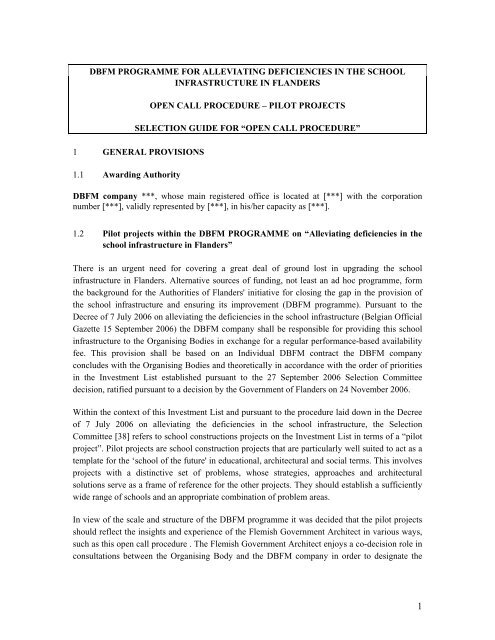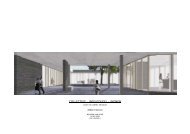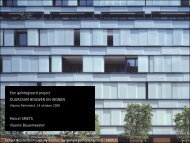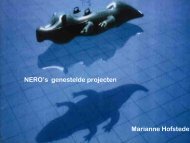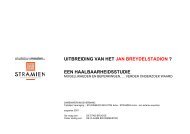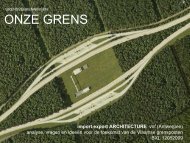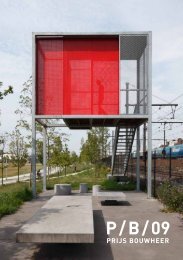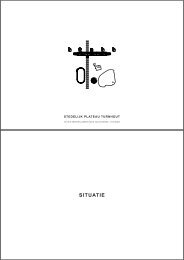here - Vlaams Bouwmeester
here - Vlaams Bouwmeester
here - Vlaams Bouwmeester
Create successful ePaper yourself
Turn your PDF publications into a flip-book with our unique Google optimized e-Paper software.
DBFM PROGRAMME FOR ALLEVIATING DEFICIENCIES IN THE SCHOOL<br />
INFRASTRUCTURE IN FLANDERS<br />
OPEN CALL PROCEDURE – PILOT PROJECTS<br />
SELECTION GUIDE FOR “OPEN CALL PROCEDURE”<br />
1 GENERAL PROVISIONS<br />
1.1 Awarding Authority<br />
DBFM company ***, whose main registered office is located at [***] with the corporation<br />
number [***], validly represented by [***], in his/her capacity as [***].<br />
1.2 Pilot projects within the DBFM PROGRAMME on “Alleviating deficiencies in the<br />
school infrastructure in Flanders”<br />
T<strong>here</strong> is an urgent need for covering a great deal of ground lost in upgrading the school<br />
infrastructure in Flanders. Alternative sources of funding, not least an ad hoc programme, form<br />
the background for the Authorities of Flanders' initiative for closing the gap in the provision of<br />
the school infrastructure and ensuring its improvement (DBFM programme). Pursuant to the<br />
Decree of 7 July 2006 on alleviating the deficiencies in the school infrastructure (Belgian Official<br />
Gazette 15 September 2006) the DBFM company shall be responsible for providing this school<br />
infrastructure to the Organising Bodies in exchange for a regular performance-based availability<br />
fee. This provision shall be based on an Individual DBFM contract the DBFM company<br />
concludes with the Organising Bodies and theoretically in accordance with the order of priorities<br />
in the Investment List established pursuant to the 27 September 2006 Selection Committee<br />
decision, ratified pursuant to a decision by the Government of Flanders on 24 November 2006.<br />
Within the context of this Investment List and pursuant to the procedure laid down in the Decree<br />
of 7 July 2006 on alleviating the deficiencies in the school infrastructure, the Selection<br />
Committee [38] refers to school constructions projects on the Investment List in terms of a “pilot<br />
project”. Pilot projects are school construction projects that are particularly well suited to act as a<br />
template for the ‘school of the future' in educational, architectural and social terms. This involves<br />
projects with a distinctive set of problems, whose strategies, approaches and architectural<br />
solutions serve as a frame of reference for the other projects. They should establish a sufficiently<br />
wide range of schools and an appropriate combination of problem areas.<br />
In view of the scale and structure of the DBFM programme it was decided that the pilot projects<br />
should reflect the insights and experience of the Flemish Government Architect in various ways,<br />
such as this open call procedure . The Flemish Government Architect enjoys a co-decision role in<br />
consultations between the Organising Body and the DBFM company in order to designate the<br />
1
successful candidates who are then taken into account for participating in the award of the<br />
contract to design the school construction projects referred to as pilot projects.<br />
The procedures according to which (i) successful candidates are identified and (ii) are then<br />
invited to participate in the following negotiating process for awarding the design contract form<br />
part of this award process (open call procedure ).<br />
1.3 Brief description of the contract<br />
The purpose of this open call procedure is to designate a designer for each pilot project who shall<br />
be responsible for producing a preliminary design for the relevant pilot project under the DBFM<br />
programme “Alleviating deficiencies in the school infrastructure in Flanders”<br />
The pilot projects are listed and briefly described as annex 2, to this selection guide. For those<br />
interested in presenting a request to participate, the awarding authority has produced an<br />
information booklet clarifying the various pilot projects. This booklet may be requested free of<br />
charge at the following URL: www.vlaamsbouwmeester.be<br />
1.4 Award procedure<br />
The designation of the successful candidates is legally based on the design competition (art. 20<br />
and 21 of the Law of 24 December 1993 read in conjunction with art. 75 up to 77 of the Royal<br />
Decree of 8 January 1996).<br />
The subsequent award of the design contract, for producing a preliminary design for the relevant<br />
pilot project, to one of the successful candidates shall be based on a negotiating process without<br />
prior notice (art. 17, §2, 4° of the Law of 24 December 1993).<br />
This open call procedure is t<strong>here</strong>fore based on a multiphase process.<br />
Phase 1: Selection of candidates invited to provide a preliminary design<br />
The first phase of the open call procedure covers the selection of the candidates : the<br />
admissibility, reliability and aptitude of the candidates are investigated in the light of the criteria<br />
referred to in this selection guide .<br />
Two-stage selection process.<br />
Against the background of a preliminary selection, the Flemish Government Architect draws up a<br />
shortlist with a maximum of 10 valid candidates who meet the minimum conditions and formal<br />
requirements. Mindful of the Flemish Government Architect's co-decision role this phase is<br />
organised subject to the responsibility and accountability of the Flemish Government Architect.<br />
2
The Selection Committee then chooses a maximum of three candidates per pilot project from the<br />
aforementioned shortlist (provided t<strong>here</strong> is a sufficient number of competent candidates featured<br />
on the shortlist drawn up by the Flemish Government Architect). Should the number of suitable<br />
candidates exceed the maximum number of three, the Selection Committee shall reduce the<br />
number of candidates to the maximum, in the light of the selection criteria referred to in point 2.4.<br />
Fase2: Choice of successful candidates in the context of the design competition<br />
The selected candidates shall be issued with an award guide w<strong>here</strong> the follow-up of the open call<br />
procedure shall be described in detail.<br />
In the second phase of the open call procedure the selected candidates shall be invited to submit a<br />
preliminary design. Based on the design competition this phase culminates in the designation of<br />
the successful candidates.<br />
Phase 3: Awarding the services contract to one of the successful candidates as a result of a<br />
negotiating process without prior notice<br />
The design contract is awarded according to a negotiating process without prior notice. All<br />
successful candidates normally take part in this negotiating process. The contract is concluded<br />
according to a model agreement for the implementation of the design contract.<br />
2 SELECTION PROCEDURE<br />
2.1 What the selection procedure involves<br />
(a)<br />
Preliminary selection by the Flemish Government Architect<br />
The first assessment of the requests to participate which are consistent with the exclusion clauses<br />
and admissibility conditions forms the background for the Flemish Government Architect<br />
drawing up a shortlist of a maximum of 10 candidates. At this stage of the procedure, requests to<br />
participate shall be assessed according to the same criteria described in point 2.4. The Flemish<br />
Government Architect's co-decision role is such that the latter shall be responsible and liable for<br />
organising this phase.<br />
(b)<br />
Further selection by the Selection Committee<br />
The second part of the selection phase is designed to allow the Selection Committee to pick a<br />
maximum of three candidates per pilot project from the shortlist (provided t<strong>here</strong> is a sufficient<br />
number of competent candidates featured on the shortlist drawn up by the Flemish Government<br />
Architect ) and after the selection process these shall be able to present a preliminary design for<br />
the relevant pilot project.<br />
3
The Selection Committee comprises the following members entitled to vote:<br />
- the Flemish Government Architect (president);<br />
- an AGIOn (Flemish Agency for Infrastructure in Education) project leader;<br />
- two representatives of the DBFM company ;<br />
- two representatives of the relevant schools groups (s) (a schools group is a voluntary cooperation<br />
arrangement between primary and secondary educational institutions of the<br />
Community Education) and/or managements.<br />
The Selection Committee's advisory opinions are issued on a collective basis. Each member has<br />
one vote.<br />
The Selection Committee's secretary is responsible for drawing up the selection report but is not<br />
entitled to vote.<br />
Should the number of suitable candidates exceed the maximum number (three) the Selection<br />
Committee shall reduce the number of candidates to the maximum in the light of the selection<br />
criteria referred to in point 2.4. (b).<br />
The selection criteria listed below are used by the Selection Committee as a basis for providing a<br />
reasoned and binding selection proposal to the awarding authority.<br />
2.2 Exclusion grounds<br />
Any candidates to whom one of the exclusion cases provided for in art. 69 of the Royal Decree of<br />
8 January 1996 applies may be prevented from taking part in this open call procedure.<br />
When making an application the candidates are required to expressly declare that their situation is<br />
not such as to bar them from participating in public contracts and they meet the requirements laid<br />
down in art. 69a of the Royal Decree of 8 January 1996.<br />
The candidates are required – on pain of exclusion – to answer all the questions or to provide any<br />
information and documents the awarding authority may request so as to check the candidate is not<br />
in a situation of being excluded.<br />
2.3 Admissibility conditions<br />
Access to the open call procedure is dependent on being featured on the association of architects<br />
list or the list of trainees (or a similar professional association in the European Union). Foreign<br />
architects have to meet the requirements of the laws of their countries for pursuing the profession<br />
of architect.<br />
4
2.4 Qualitative selection criteria<br />
(a)<br />
Financial and economic capacity<br />
The candidates have to show they have a sufficient financial and economic capacity to fulfil the<br />
contract and to do so by offering evidence that they are insured against professional liability, with<br />
an appropriate level of basic coverage for the projects the candidates choose.<br />
(b)<br />
Technical aptitude<br />
The candidates have to show they have the right technical aptitude to fulfil the contract and to do<br />
so by presenting the following documents and references:<br />
- A description of the “office”: a statement about the in-house organisation, the composition of<br />
the office, the technical equipment and facilities the service providers have for the provision of<br />
services. The description also features (i) a description / assessment of the availability of the team<br />
given the scale and number of pilot projects for which the candidate has presented a request to<br />
participate and (ii) a list of the declarations of intent about the partnerships the candidate intends<br />
to enter into for the fulfilment of the contract.<br />
- Portfolio of designs and achievements: a brief presentation, with text, photographs and/or<br />
drawings, to specify what designs and projects the candidate has already completed. Against the<br />
background of each pilot project a reference is made in the portfolio – under pain of irregularity –<br />
to the specific maximum of three projects, similar or otherwise, in a personal capacity, allowing<br />
the conceptual capacity to be assessed in the light of the pilot project registered for.<br />
In the portfolio t<strong>here</strong> is a clarification for each project referred to: the customer, short description<br />
of the service, the cost price of the services and the (estimated) cost price of the completed<br />
project. If several pilot projects are being applied for under this call, the references should spell<br />
out for which pilot project they are being submitted, with due regard to the aforementioned<br />
maximum of three projects per pilot project.<br />
Without detracting from the aforementioned maximum-related obligation and the specification<br />
that has to be provided for each reference, the candidate's application form may refer to the<br />
presentation brochures for the candidate's office and monographs of the candidate's work<br />
available to the Flemish Government Architect pursuant to a recent application for the open call.<br />
The aforementioned documents should make it possible to build a picture of the vision, approach<br />
and quality of the candidate's achievements and more particularly :<br />
1. the general design-driven expertise in the light of the project assignment;<br />
2. the general analytical and conceptual capacities in landscape, urban development and,<br />
architectural terms and in terms of sustainability;<br />
5
3. the specific project-oriented team expertise;<br />
4. team composition, professional competence and relevant experience.<br />
3 REQUEST TO PARTICIPATE<br />
3.1 Time limit and procedure for submitting the request to participate<br />
The candidates have to submit a request to participate (in duplicate and suitably bound)<br />
comprising :<br />
- the participation form with a declaration on honour about the grounds for exclusion and<br />
admissibility conditions, duly completed and signed by the competent person or persons;<br />
- documents about the qualitative selection criteria.<br />
The candidates' requests to participate must express their intention to enter into partnerships (for<br />
example, with other designers and/or design offices). In the application it suffices to mention the<br />
intention to enter into a partnership and the task of the partners.<br />
Applications to participate should reach the services of the Flemish Government Architect, Graaf<br />
de Ferraris-gebouw, Koning Albert II-laan 20 bus 9, 1000 Brussels, on *** at *** am/pm in<br />
respect of ***. The applications to participate may be delivered against acknowledgement of<br />
receipt, or sent.<br />
The application is confined to projects the candidates choose from amongst the list of pilot<br />
projects.<br />
3.2 Errors and omissions<br />
Should a candidate notice any errors and/or omissions in this document and even if these errors<br />
and/or omissions should allow or not prevent the candidate from submitting a request to<br />
participate, the candidate needs to mention such errors and/or omissions (and at the latest 10 days<br />
before the date for submitting the requests to participate), voluntarily and in writing, at the<br />
contact address provided in the notice, so the awarding authority shall be able to take the<br />
appropriate action to correct this.<br />
3.3 Language<br />
The candidates shall use solely Dutch in their verbal and written contacts with the customer. In<br />
the event of documents available only in another language, the customer may require a sworn<br />
translation, w<strong>here</strong> appropriate.<br />
6
DBFM PROGRAMME FOR ALLEVIATING DEFICIENCIES IN THE SCHOOL<br />
INFRASTRUCTURE IN FLANDERS<br />
1 GENERAL PROVISIONS<br />
1.1 Introduction<br />
OPEN CALL PROCEDURE - PILOT PROJECTS<br />
AWARD GUIDE FOR “OPEN CALL PROCEDURE”<br />
This award guide offers a description of the procedure and the rules that apply for the period<br />
starting from the invitation to the selected candidates to the submission of the preliminary design in<br />
the context of the competition, the designation of the successful candidates, and the award of the<br />
design contract and the conclusion of a contract with a designer (in accordance with the model<br />
agreement for the fulfilment of the study contract).<br />
The awarding authority reserves the right, w<strong>here</strong> necessary or required, to amend, supplement or<br />
clarify this document. Any amendments, additions and/or clarifications are announced to the<br />
candidates on the basis of a registered letter (with acknowledgement of receipt) or via e-mail with<br />
confirmation of receipt by the candidates.<br />
1.2 Awarding Authority<br />
DBFM company ***, whose main registered office is located at [***] with the corporation number<br />
[***], validly represented by [***], in his/her capacity as [***].<br />
Information about this tender document is available from: ***.<br />
Any correspondence to the customer should be sent in written form by letter, fax or e-mail to the<br />
above address.<br />
1.3 Brief description of the contract<br />
The purpose of this open call procedure is to designate one or more successful candidates for each<br />
pilot project under the DBFM programme “Alleviating deficiencies in the school infrastructure in<br />
Flanders”, and in particular designating successful candidates for [further clarification of pilot<br />
project ], located at [***] as described in detail in annex 2 to this award guide.<br />
As an annex to this award guide a project file is included, which features the project definition, the<br />
statement of requirements, the level of investments, the calculation method, the timetable, location<br />
details the urban development and other preconditions for the pilot project. The project definition
provides the quality requirements, while forming the assessment framework for the quality control<br />
and provides a perspective on the ambition and expectations of the awarding authority and the<br />
organising body, the user of the pilot project.<br />
The services contract to be fulfilled in the wake of the design competition shall be awarded to one<br />
of the successful candidates according to the process determined in this guide. The contract<br />
involves producing a preliminary design for establishing the pilot project at [***] in the context of<br />
the DBFM programme “Alleviating deficiencies in the school infrastructure in Flanders”.<br />
1.4 Regulations applicable to this open call procedure<br />
1. The Law of 24 December 1993 (Belgian Official Gazette of 22/01/1994) concerning public<br />
contracts and some contracts to make up works, deliveries and services and subsequent<br />
amendments<br />
2. The Royal Decree of 8 January 1996 (Belgian Official Gazette of 26/01/1996) concerning<br />
public contracts to make up works, deliveries and services and subsequent amendments;<br />
3. The Royal Decree of 26 September 1996 (Belgian Official Gazette of 18/10/1996) for<br />
determining the general implementation regulations for public contracts and concessions<br />
for public works, as well as the annex to the Royal Decree concerning the general<br />
conditions and subject amendments;<br />
1.5 Overview of the awarding procedure<br />
Pursuant to the Decree of 7 July 2006 on alleviating the deficiencies in the school infrastructure<br />
(Belgian Official Gazette of 15 September 2006) it was decided to establish a special open call<br />
procedure for designating designers for school construction projects identified as pilot projects in<br />
the investment list featured in the DBFM programme “Alleviating deficiencies in the school<br />
infrastructure in Flanders”.<br />
Under this heading it has been decided to launch a selection procedure on the basis of a design<br />
competition : the contract notice was published in the Belgian Law Gazette on *** and in the<br />
Official Journal of the European Communities on *** ( dispatches ***). A selection guide related<br />
to the “open call procedure” was produced for the purpose of choosing the candidates.<br />
A selection report with the reference *** of *** was presented as part of the candidate selection<br />
process. The selected candidates were then provided with this tender document (award guide for the<br />
“open call procedure”).<br />
The awarding process unfolds in two stages.<br />
2
- The designation of the successful candidates has its legal basis in the design competition<br />
(art. 20 and 21 of the Law of 24 December 1993 read in conjunction with art. 75 to 77 of<br />
the Royal Decree of 8 January 1996). This part of the open call procedure is described in<br />
detail in point 2.<br />
- The subsequent award of the design contract, for producing a preliminary design for the<br />
relevant pilot project, to one of the successful candidates, shall be based on a negotiating<br />
process without prior notice (art. 17, §2, 4° of the Law of 24 December 1993) (according to<br />
a model agreement for the implementation of the study contract ). This part of the open<br />
call procedure is described in detail in point 3.<br />
1.6 Application files<br />
Information provided as part of the selection process is conclusively replaced by this award guide,<br />
hence candidates may no longer refer to information in the selection guide and the notice.<br />
Exceptions to the foregoing are provisions in the notice and selection guide related to the selection<br />
concerning exclusions grounds, admissibility, technical and organisational competence and<br />
financial capacity. This means that during the next stages of the procedure, candidates have to<br />
comply with the requirements laid down t<strong>here</strong>.<br />
The documents demonstrating that the participation conditions are met and for which a declaration<br />
has been signed by the candidate in the selection stage are provided to the awarding authority no<br />
later than at the time of the invitation to the negotiating procedure.<br />
If, during the awarding procedure, the candidate turns out to be in a situation that may lead to<br />
exclusion, t<strong>here</strong> is still scope for deciding upon an exclusion.<br />
2 DESIGNATION OF SUCCESSFUL CANDIDATES AS A RESULT OF THE<br />
DESIGN COMPETITION<br />
2.1 Invitation to submit a preliminary design<br />
With the written and simultaneous invitation for the candidates selected for this pilot project to<br />
submit a preliminary design, in the form and according to the procedure determined below, the<br />
candidates are provided with the award guide including the project file.<br />
2.2 Scope for written questions<br />
The candidates are offered the opportunity to ask questions about this award guide. These questions<br />
have to be presented to the awarding authority by e-mail no later than ***. The awarding authority<br />
freely decides whether or not to answer the questions that are forwarded. Should the awarding<br />
3
authority decide this is appropriate or necessary, the relevant candidates may be asked to provide<br />
further clarification with the questions.<br />
2.3 Briefing<br />
At least one briefing per pilot project is organised as a result of arranging a joint meeting. The<br />
briefing is intended to provide an opportunity for consultations between the awarding authority and<br />
the selected candidates, and for allowing the contract to continue to be explored in the context of an<br />
open dialogue and for questions to be asked that may be submitted by preference in writing. The<br />
candidates may also put questions verbally about the project, the site or their design contract. A<br />
visit is also made to the construction site, or building. The awarding authority reserves the right to<br />
be assisted by third parties, w<strong>here</strong> appropriate (such as the fire service, town planning, land-use<br />
planning, monuments and landscapes) for specific explanations.<br />
During the briefing a sealed envelope per candidate is drawn at random, containing a specimen<br />
offer form featuring a code (a code comprising the number of the pilot project under the open call<br />
followed by a letter A, B, or C). This envelope has 6 stickers with the aforementioned letter code (5<br />
for on the envelopes with project packages, one with a specific reference to "offer form" for on the<br />
envelope with the offer form and the team composition).<br />
2.4 Submitting the preliminary design<br />
The candidates next have to provide their preliminary designs to the awarding authority and do so<br />
within the period mentioned in point 4.1. As defined more precisely in point 4.1., the preliminary<br />
designs are submitted anonymously to the Evaluation Committee.<br />
The preliminary design represents the candidate's personal vision of the forthcoming assignment,<br />
involving the creation of a preliminary design for the pilot project. This conceptual study comprises<br />
a written and graphic presentation.<br />
The candidates have to submit the following documents, on pain of irregularity, as part of the<br />
preliminary design:<br />
- Document concerning the designer's concept or exploratory vision about the designer's<br />
approach to the assignment, in the light of the objectives and underlying principles expressed in<br />
the project definition [and the approach concerning the sustainable building factors];<br />
- Sketches, drawings, visual or other material needed to spell out how the vision is worked out<br />
in material terms and reflected, a package with draft original drawings of the entire pilot<br />
project, comprising, at the very least:<br />
(i)<br />
a general location plan;<br />
4
(ii)<br />
plans of all the floors, front perspectives and cross-sections;<br />
- (Detailed) substantiated estimates for the pilot project to be completed, with due regard – for<br />
the parts that come under this heading – for the maximum cost price that may be taken into<br />
account according to the financial standard for the relevant pilot project;<br />
- An initial review of the concept for the pilot project in the light of the physical and financial<br />
standards;<br />
- Proposed fee for fulfilling the services contract pursuant to the model agreement for fulfilling<br />
the study contract ;<br />
- Realistic implementation period for the project to be carried out ;<br />
- A working proposal and a proposed fee for the quality control or supervision assignment in<br />
the follow-up to the planning process. The awarding authority reserves the right, but without<br />
being obliged to do so, to grant these additional elements to the chosen service provider. In<br />
view of the operational nature of the additional services, the candidates' proposals in this area<br />
are not taken into account for the assessment of the proposals for the competition and the<br />
service contract.<br />
Formal requirements :<br />
The plans, cross-sections and elevations feature all the appropriate indications to be able to<br />
understand the candidate's aims and make the drawings easy to read. The preliminary design should<br />
in particular show: the orientation, the entrances, levels, the modulation, the intended purpose of the<br />
facilities, the traffic, the key dimensions, the type of materials and the relief of the ground.<br />
2.5 Assessment of the preliminary designs in the context of the competition<br />
The preliminary designs produced by the candidates shall be reviewed by the Evaluation<br />
Committee in the light of the assessment criteria listed below, with the project file serving as the<br />
frame of reference. The Evaluation Committee reaches its decision within this context.<br />
(a)<br />
Assessment criteria<br />
The assessment criteria the Evaluation Committee uses to select the successful candidates are as<br />
follows:<br />
1. the quality of the preliminary design and the design-driven research in terms of the landscape<br />
design, town planning, architecture, interior design and art related to the aspirations and<br />
expectations, as expressed in the project file (*** %);<br />
5
2. the focus on a global approach to sustainability (*** %);<br />
3. the project cost (*** %).<br />
(b)<br />
Composition and operating procedures of the Evaluation Committee<br />
The Evaluation Committee comprises the following members entitled to vote :<br />
- the Flemish Government Architect (president);<br />
- an outside expert appointed by the Flemish Government Architect<br />
- an AGIOn (Flemish Agency for Infrastructure in Education) project leader;<br />
- two representatives of the DBFM company ;<br />
- two representatives of the relevant schools groups (s) (a schools group is a voluntary cooperation<br />
arrangement between primary and secondary educational institutions of the<br />
Community Education) and/or managements.<br />
The Evaluation Committee's advisory opinions are issued on a collective basis. Each member has<br />
one vote.<br />
The Evaluation Committee's secretary is responsible for drawing up the evaluation report but is not<br />
entitled to vote.<br />
The candidates' preliminary designs shall first of all be assessed according to their completeness<br />
and a check is made to see if they are consistent with the formal requirements (regularity), such as<br />
being submitted in good time. An incomplete preliminary design or one that is inconsistent with the<br />
formal requirements may be automatically excluded.<br />
A review is also made to see if the preliminary designs comply with the minimum requirements, as<br />
specified in this tender document. The preliminary designs that do not comply with the minimum<br />
requirements in this tender document may automatically be excluded from any further assessment.<br />
The formally valid preliminary designs that are given a positive assessment in the light of the<br />
established minimum requirements, as laid down in this tender document, and thus qualify for a<br />
further assessment, are assessed in the light of the assessment criteria established for designating<br />
the successful candidates.<br />
The Evaluation Committee issues a reasoned decision, w<strong>here</strong> a concrete and detailed justification is<br />
provided, on the basis of each assessment criterion, for the candidates designated as successful<br />
candidates. The Evaluation Committee's decision is binding. The assessment report at the very least<br />
6
contains the key points of the deliberations and the justification for the choice. In the light of the<br />
assessment of the preliminary designs the Evaluation Committee may, without being obliged to do<br />
so, prepare for the negotiating procedure, as defined more precisely in point 3 of this award guide,<br />
formulate a proposal concerning the clarifications and questions that can be presented to the<br />
successful candidates.<br />
Candidates not designated as successful candidates are notified t<strong>here</strong>of in a registered letter and<br />
about the reasoned assessment decision.<br />
(c)<br />
Reward for successful candidates<br />
The selected candidates who the Evaluation Committee designates as successful candidates may<br />
claim the sum of Euro... [not including VAT] against the Flemish Government Architect budgets,<br />
as a reward for producing the preliminary design. After being notified that they have been<br />
designated as successful candidates, the latter may present a claim [more detailed explanation of the<br />
invoicing details] which may be charged against the Flemish Government Architect's budgets. The<br />
reward is paid within two months after the claim is presented. The fee for the designer to whom the<br />
design contract is awarded is not reduced by the value of this reward.<br />
3 DESIGNATION OF THE DESIGNER AS A RESULT OF THE NEGOTIATING<br />
PROCEDURE WITHOUT PRIOR NOTICE<br />
3.1 Invitation to take part in the negotiating procedure<br />
The successful candidates selected in the context of the competition for the relevant pilot project<br />
are invited for the negotiations. Towards this end, all the successful candidates are invited, at a date<br />
and time still to be announced, to present the preliminary design they submitted, and to do so in the<br />
form and according to the procedure defined below.<br />
3.2 Presentation and explanation of the preliminary designs submitted and proposal for<br />
an agreement for the fulfilment of the study contract<br />
The presentation and explanation is undertaken on *** at ** am/pm at the following location<br />
[clarification ***].<br />
Each successful candidate is assigned 30 minutes to explain the preliminary design he/she<br />
submitted. Each successful candidate is also obliged to express in essence what, in his/her opinion,<br />
the fulfilment of the study contract should involve. The tender document is accompanied by an<br />
agreement (model agreement for the fulfilment of the study contract) that forms an integral part of<br />
the applicable documents. This agreement features the provisions and conditions applicable to the<br />
fulfilment of the design contract.<br />
7
The presentation is undertaken alphabetically according to the code as referred to in point 2.3. of<br />
this tender document. Subsequent to the explanation 15 minutes is earmarked for the Awarding<br />
Committee to allow questions to be asked about the preliminary design submitted. The explanation<br />
is normally undertaken on a joint basis, such that successful candidates may be present during the<br />
explanation of fellow successful candidates. During the questions, successful candidates not<br />
presenting leave the room. Should one of the successful candidates not agree to provide an<br />
explanation in the presence of the other successful candidates, all explanations are undertaken in the<br />
absence of the other successful candidates. A decision is taken in consultation with all candidates<br />
no later than the briefing about this way of presenting.<br />
3.3 Assessment in the context of the negotiating procedure<br />
(a)<br />
Award procedure<br />
It is up to the awarding authority (DBFM company ) actually to conclude an agreement with a<br />
designer on the basis of a model agreement for the fulfilment of the study contract. This applies to a<br />
separate services contract (apart from the competition ) concluded on the basis of a negotiating<br />
procedure without any prior notice.<br />
During this phase the awarding authority is assisted by the Awarding Committee, which issues a<br />
non-binding advisory opinion about this matter.<br />
(b)<br />
Award criteria<br />
The preliminary designs (including the presentation, the explanation provided, information that may<br />
not be taken into account for the competition owing to the need for anonymity ) shall be assessed<br />
according to the award criteria mentioned below.<br />
The criteria used are as follows.<br />
1 the quality of the preliminary design and design-driven research in terms of landscape<br />
design, town planning, architecture related to the aspirations and expectations, as formulated in the<br />
project file (***%);<br />
2 the process orientation and process preparedness (*** %);<br />
3 the focus on a global approach to sustainability (*** %);<br />
4 cost management concerning fee and project cost (*** %);<br />
5 completion time (*** %).<br />
8
(c)<br />
Composition and operating procedures of the Awarding Committee<br />
The Awarding Committee comprises:<br />
- the Flemish Government Architect;<br />
- an external expert appointed by the Flemish Government Architect;<br />
- an AGIOn project leader ;<br />
- two representatives of the DBFM company (including the president of the Awarding<br />
Committee);<br />
- two representatives of the relevant schools group (s) and/or managements.<br />
The Awarding Committee's advisory opinions are taken on a collective basis. Each member has one<br />
vote.<br />
The secretary of the Awarding Committee is responsible for drawing up the Awarding Committee<br />
report and is not entitled to vote. The Awarding Committee report contains the deliberations and the<br />
justification for its choice.<br />
(d)<br />
Award decision<br />
On the basis of the assessment as referred to in point 3.3.(c) the Awarding Committee issues the<br />
awarding authority with a reasoned non-binding advisory opinion about awarding the design<br />
contract.<br />
On the basis of this and, w<strong>here</strong> appropriate, in the light of its own additional assessment of the<br />
preliminary designs, presentation and explanation, the awarding authority designates the successful<br />
candidate with the best score in the light of the award criteria (preferred successful candidate)<br />
referred to in point 3.3.(b).<br />
(e)<br />
Finale contract meeting<br />
Except in duly reasoned circumstances, the preferred successful candidate is invited as the only one<br />
for the final contract meetings.<br />
The other successful candidates shall be invited to the holding of such a contract meeting only if the<br />
contract meeting with the preferred successful candidate cannot be brought to a successful<br />
conclusion. The main purpose of this final contract meeting shall be to ensure best overall value and<br />
to clarify the scope of the rights and obligations to be addressed.<br />
9
The contract is undertaken only when the final contract documents are signed. Until such time, the<br />
awarding authority is not bound to the intended service contract.<br />
The successful candidates whose offers – if appropriate after the final contract meetings – are not<br />
judged to be the most advantageous ones are notified t<strong>here</strong>of by registered letter and about the<br />
reasoned award decision, mentioning the period within which the awarding authority shall<br />
definitely not conclude the contract.<br />
The awarding authority does not accept any liability should the procedure not be followed up, as a<br />
result, for example, of decisions by other administrations or authorities.<br />
4 SUBMITTING THE PRELIMINARY DESIGNS<br />
4.1 Period and procedure for submitting preliminary designs<br />
The preliminary designs have to be submitted at the latest on *** at ** am/pm. The preliminary<br />
designs are submitted anonymously to the Flemish Government Architect [clarification ***].<br />
The candidates submit 5 copies of their preliminary design, with each copy being in a separate<br />
envelope with a reference to the code provided to each candidate during the briefing. The offer<br />
form, containing the candidate's code and identity, is presented in duplicate in a separate<br />
conclusively sealed envelope. All documents with information in which it is necessary to refer to<br />
the identity of the candidate (such as reference projects, team composition,…) are added, in<br />
duplicate, with the offer form in a sealed envelope. Consequently, 6 envelopes (1 with offer form<br />
and documents with identity and 5 with the preliminary design) are provided.<br />
Each preliminary design also has to be submitted in a digital form on a CD-ROM in a pdf format.<br />
In the event of inconsistencies between analogue and digital versions, the analogue version takes<br />
precedence over the digital one.<br />
4.2 Requirements for the preliminary designs<br />
When preparing the preliminary design the candidate has to take account of the annexes to this<br />
tender document.<br />
The candidate's preliminary design has to provide a sufficient explanation for each of the<br />
assessment criteria and/or award criteria, and any documents needed or useful for the assessment of<br />
this have to be enclosed.<br />
A failure to enclose the required documentation or the failure to observe the minimum requirements<br />
may lead to exclusion from this procedure.<br />
10
The file the candidates submit must at the very least consist of:<br />
(a)<br />
Information about the candidate<br />
Information about the candidate is referred to in an accompanying letter (including a duly<br />
completed and signed offer form): in a separate envelope, as established in point 4.1. This<br />
accompanying letter also contains a list of people who are competent to represent the candidate and<br />
any restrictions on their power of representation. Should the preliminary design be submitted by a<br />
proxy, the instrument granting the person this authorisation has to be enclosed, as well as a certified<br />
copy of the original document or a copy of the annex of the Belgian Official Gazette in which the<br />
powers of the proxy were published.<br />
The candidate has to use the accompanying letter to specify what partnerships the design team enter<br />
into for the fulfilment of the contract, insofar as the cooperating offices have not yet been presented<br />
in the context of the file submitted during the selection phase. In this case a brief introduction to the<br />
cooperating offices has to be enclosed, featuring, at the very least, a short explanatory document<br />
about the operation and aspirations, a presentation of the internal organisation and infrastructure<br />
and presentations of the person's own work.<br />
In the event of a group, the offer form has to be signed by all participants in the group which are<br />
jointly and severally committed in this context. Evidence of the authority to sign has to be annexed<br />
for each member of the group who signs.<br />
The customer reserves the right to accept a preliminary design from a temporary association,<br />
insofar as at least one selected candidate forms part of the association.<br />
(b)<br />
Further requirements for the content of the preliminary design<br />
Apart from the accompanying letter, the candidates have to submit the following documents, on<br />
pain of irregularity, as part of the preliminary design:<br />
- Document concerning the designer's concept or exploratory vision about the designer's<br />
approach to the assignment, in the light of the objectives and underlying principles expressed in<br />
the project definition [and the approach concerning the sustainable building factors];<br />
- Sketches, drawings, visual or other material needed to spell out how the vision is worked out<br />
in material terms and reflected, a package with draft original drawings of the entire pilot<br />
project, comprising, at the very least:<br />
(i)<br />
(ii)<br />
a general location plan;<br />
plans of all the floors, front perspectives and cross-sections;<br />
11
- (Detailed) substantiated estimates for the pilot project to be completed, with due regard – for<br />
the parts that come under this heading – for the maximum cost price that may be taken into<br />
account according to the financial standard for the relevant pilot project;<br />
- An initial review of the concept for the pilot project in the light of the physical and financial<br />
standards;<br />
- Proposed fee for fulfilling the services contract pursuant to the model agreement for fulfilling<br />
the study contract ;<br />
- Realistic implementation period for the project to be carried out ;<br />
- A working proposal and a proposed fee for the quality control or supervision assignment in the<br />
follow-up to the planning process.<br />
(c)<br />
Presentation material<br />
The successful candidates who are invited to present the preliminary design they submitted in the<br />
context of the negotiating procedure have to ensure the presentation material used by them is<br />
provided on a CD-Rom.<br />
The presentation material has to meet the following requirements:<br />
- A text with a brief project description and a summary of the design principles involving<br />
roughly 1,000 to 1,500 characters.<br />
- A complete PowerPoint presentation with ppt extension [no pdf version].<br />
- All visual material [also from ppt] separate, with tif or jpg extension at 75 dpi resolution<br />
with a minimum A4 format and at 300 dpi resolution with a minimum A4 format.<br />
- All vectorial files [plans, 3D drawings, …] with eps, pdf or ai extension.<br />
4.3 Acceptance period<br />
The period during which a candidate continues to be bound by his/her preliminary design is<br />
increased to [90] calendar days.<br />
4.4 Variations<br />
Variations are not allowed.<br />
Each candidate may submit only one preliminary design per pilot project.<br />
12
4.5 Intellectual property<br />
The candidates <strong>here</strong>by transfer, conclusively and irrevocably, without any restriction and<br />
unencumbered, all intellectual property rights to the awarding authority (including the rights<br />
subcontractors have transferred to them in the light of the agreements specified above (or shall<br />
transfer) concerning the preliminary design (design documents, embodied work, ensuing design or<br />
work,…). Intellectual property rights cover all present and future intellectual property rights, in<br />
their most comprehensive form (including but not limited to: copyright, patents, trade mark rights,<br />
design rights, domain names, database rights and know-how) that shall arise or do arise in<br />
connection with the preliminary design documents, the works embodied t<strong>here</strong>in. The candidates<br />
retain the intellectual rights for the designs they submit.<br />
As the transfer in advance of forthcoming intellectual property rights is impossible, the candidate<br />
should act at any time required by the awarding authority to do everything that is necessary<br />
ultimately to transfer these rights to the customer.<br />
The awarding authority may realise (“reproduce” within the meaning of article 1 of the Belgian<br />
Copyright Law) the preliminary design and/or work that is established and/or embodied in the<br />
preliminary design documents, entirely or partly, with or without the involvement of the candidate<br />
or the latter's subcontractor (s), for the benefit of the relevant pilot project, provided the identity of<br />
the designer is mentioned.<br />
Should the awarding authority realise (“reproduce” within the meaning of article 1 of the Belgian<br />
Copyright Law) the preliminary design and/or work that is established and/or embodied in the<br />
preliminary design documents, without the involvement of the candidate or the latter's<br />
subcontractor (s), the awarding authority does not have to pay any additional compensation.<br />
Should t<strong>here</strong> be a question of a claim from a third party concerning infringements of intellectual<br />
(property) rights the candidate accepts the obligation to take all measures, at the latter's costs, that<br />
may help to prevent a delay in the fulfilment of the contract and to limit the costs incurred and/or<br />
damaged suffered by the customer.<br />
5 MUTUAL OBLIGATIONS DURING THE OPEN CALL PROCEDURE<br />
5.1 Agreement with the procedure<br />
As a result of submitting a preliminary design the candidates accept the implementation of the open<br />
call procedure as described above and agree themselves to be bound the provisions t<strong>here</strong>of as if it<br />
were a contract. Should a candidate have any objections in this connection, the candidate should<br />
notify the customer t<strong>here</strong>of, describing the reasons, and do so in writing sent by registered letter<br />
within one week after receiving this document .<br />
13
5.2 Transfer of rights and obligations by the customer<br />
The candidate agrees to the awarding authority's potential transfer to third parties of the rights and<br />
obligations ensuing from this contract.<br />
5.3 Examining for regularity and completeness<br />
Once the tender document has been received and any additional items each candidate has to check<br />
the documents provided for their completeness and regularity, including the annexes and<br />
memoranda.<br />
Should a candidate notice any errors and/or omissions in this document and even if these errors<br />
and/or omissions should allow or not prevent the candidate from submitting a preliminary design,<br />
the candidate needs to mention such errors and/or omissions (and at the latest 10 days before the<br />
date for submitting the preliminary designs), voluntarily and in writing, at the contact address<br />
provided in the notice, so the contracting authority shall be able to take the appropriate actions to<br />
correct this.<br />
Pursuant to this document, the awarding authority provides the candidates with all the information<br />
available to and known to the authority. The candidates are responsible for gathering all the<br />
additional information they need to be able to submit a preliminary design.<br />
14


